Noise Reduction Method for the Vibration Signal of Reactor CRDM Based on CEEMDAACN-SK
Abstract
:1. Introduction
- In view of the characteristics of large interference and the difficulty in analyzing the vibration monitoring signal of the CRDM, the CEEMDAACN algorithm is proposed to decompose the vibration signal of the CRDM and obtain the IMF components. The IMF component includes vibration signals that can reflect the state of the CRDM and other components, such as noise.
- The IMF component of the vibration signal of a CRDM is analyzed by the SK algorithm, and the spectral kurtosis of each IMF component is obtained, so as to obtain the IMF component containing fault and degradation signals and complete the noise reduction of the original signal.
- The CEEMDAACN-SK method is analyzed and verified by using the life experimental data of the CRDM, and the verification results are compared with the CEEMDAN-SK method.
2. Noise Reduction Method for the Vibration Signal of the CRDM
2.1. CEEMDAN Algorithm
2.2. CEEMDAACN Algorithm
2.3. SK Algorithm
2.4. Noise Reduction Scheme for the Vibration Signal of a CRDM Based on CEEMDAACN-SK
3. Analysis of Experimental Results
4. Conclusions
Author Contributions
Funding
Data Availability Statement
Conflicts of Interest
References
- Lee, Y.K.; Lee, J.H.; Kim, H.W.; Kim, S.K.; Kim, J.B. Drop Performance Test of Conceptually Designed Control Rod Assembly for Prototype Generation IV Sodium-Cooled Fast Reactor. Nucl. Eng. Technol. 2017, 49, 855–864. [Google Scholar] [CrossRef]
- Kim, I.G.; Bang, I.C. Hydraulic control rod drive mechanism concept for passive in-core cooling system (PINCs) in fully passive advanced nuclear power plant. Exp. Therm. Fluid Sci. 2017, 85, 266–278. [Google Scholar] [CrossRef]
- Wang, F.; Xue, S.; Jiang, E. Study on Change of Chromium Plating Thickness of Threads of Control Rod Drive Mechanism of Nuclear Power. Mater. Sci. Forum 2019, 956, 125–134. [Google Scholar] [CrossRef]
- Liu, Q.F.; Hu, G.; Bo, H.L. Parameter characteristic analysis of step-down of hydraulic cylinder motion for control rod hydraulic drive system based on Model II. J. Nucl. Sci. Technol. 2019, 56, 263–277. [Google Scholar] [CrossRef]
- Mu, H.; Yan, H.; Yi, X.; Yang, Y.; Chen, G.; Dong, X. The Reliability Optimization Allocation Method of Control Rod Drive Mechanism Based on GO Method. In Proceedings of the 2019 International Conference on Sensing, Diagnostics, Prognostics, and Control (SDPC), Beijing, China, 15–17 August 2019. [Google Scholar]
- Yockey, W.; Ali, A.; Pope, C. Development of a new control rod drive mechanism design for the ISU AGN-201M reactor. Ann. Nucl. Energy 2022, 167, 108817. [Google Scholar] [CrossRef]
- Lish, M.R.; Upadhyaya, B.R.; Hines, J.W. Development of I2S-LWR instrumentation systems. Ann. Nucl. Energy 2017, 100, 23–30. [Google Scholar] [CrossRef]
- Sathiyasheela, T.; Natesan, K.; Srinivasan, G.; Devan, K.; Puthiyavinayagam, P. Analysis of unprotected transients with control and safety rod drive mechanism expansion feedback in a medium sized oxide fuelled fast breeder reactor. Nucl. Eng. Des. 2015, 291, 1–9. [Google Scholar] [CrossRef]
- Bakhri, S. Investigation of Rod Control System Reliability of Pwr Reactors. KnE Energy 2016, 1, 94–105. [Google Scholar] [CrossRef]
- Yang, Y.; Xu, Q.; Chen, Y.; Wang, Q.; Yu, T.; Chen, X. An Improved Calculational Model for Inductance of CRDM Based on Equivalent Magnetic Circuit. IEEE Trans. Nucl. Sci. 2022, 69, 2205–2213. [Google Scholar] [CrossRef]
- Yang, P.; Huang, B.; McCoul, D.; Xie, D.; Li, M.; Zhao, J. A Soft Crawling Robot with a Large-Range Omnidirectional Deformable Rectangular Spring for Control Rod Drive Mechanism Inspection. Soft Robot. 2023, 10, 280–291. [Google Scholar] [CrossRef]
- Zhang, L.; Li, Q.; Luo, J.; Liu, M.; Wang, Y.; Li, L. A novel method for diagnosis and de-noising of control rod drive mechanism within floating nuclear reactor. Ocean Eng. 2022, 244, 110398. [Google Scholar] [CrossRef]
- Yu, T.; Fu, G.; Yu, Y.; Zhu, L.; Liu, M.; Li, W.; Deng, Q.; Cai, Z. Wear Characteristics of the Nuclear Control Rod Drive Mechanism (CRDM) Movable Latch Serviced in High Temperature Water. Chin. J. Mech. Eng. 2022, 35, 26. [Google Scholar] [CrossRef]
- Coules, H.E.; Smith, D.J. Measurement of the residual stresses in a PWR Control Rod Drive Mechanism nozzle. Nucl. Eng. Des. 2018, 333, 16–24. [Google Scholar] [CrossRef]
- Novak, O.; Sklenka, L.; Fejt, F.; Maldonado, I.; Chvala, O. Rod drop transient at VR-1 reactor–Experiment and Serpent transient calculation analysis. Ann. Nucl. Energy 2020, 141, 107296. [Google Scholar] [CrossRef]
- Son, J.G.; Lee, J.H.; Kim, H.W.; Kim, S.K.; Kim, J.B. Influence of design modification of control rod assembly for Prototype Generation IV Sodium-cooled Fast Reactor on drop performance. Nucl. Eng. Technol. 2019, 51, 922–929. [Google Scholar] [CrossRef]
- Tan, S.; Hao, G.; Guo, J.; Yu, J.; Wang, P. High-Quality Signal Denoising and Deep Feature Representation and Its Application to the ENPEMF. IEEE Geosci. Remote Sens. Lett. 2022, 19, 8029405. [Google Scholar] [CrossRef]
- Li, F.; Sun, F.; Liu, N.; Xie, R. Denoising Seismic Signal via Resampling Local Applicability Functions. IEEE Geosci. Remote Sens. Lett. 2022, 19, 7501605. [Google Scholar] [CrossRef]
- Rey, S.; Segarra, S.; Heckel, R.; Marques, A.G. Untrained Graph Neural Networks for Denoising. IEEE Trans. Signal Process. 2022, 70, 5708–5723. [Google Scholar] [CrossRef]
- Wang, X.; Chen, B.; Zeng, M.; Wang, Y.; Liu, H.; Liu, R.; Tian, L.; Lu, X. An ECG Signal Denoising Method Using Conditional Generative Adversarial Net. IEEE J. Biomed. Health Inform. 2022, 26, 2929–2940. [Google Scholar] [CrossRef]
- Caldeira, A.; Coelho, R. EEMD-IF Based Method for Underwater Noisy Acoustic Signals Enhancement in Time-Domain. IEEE Signal Process. Lett. 2023, 30, 294–298. [Google Scholar] [CrossRef]
- Liu, X.; Wang, H.; Huang, Y. SCBSS Signal De-Noising Method of Integrating EEMD and ESMD for Dynamic Deflection of Bridges Using GBSAR. IEEE J. Sel. Top. Appl. Earth Obs. Remote Sens. 2021, 14, 2845–2856. [Google Scholar] [CrossRef]
- Wang, R.; Huang, W.; Hu, B.; Du, Q.; Guo, X. Harmonic Detection for Active Power Filter Based on Two-Step Improved EEMD. IEEE Trans. Instrum. Meas. 2022, 71, 1–10. [Google Scholar] [CrossRef]
- Vijayvargiya, A.; Gupta, V.; Kumar, R.; Dey, N.; Tavares, J.M.R.S. A Hybrid WD-EEMD sEMG Feature Extraction Technique for Lower Limb Activity Recognition. IEEE Sens. J. 2021, 21, 20431–20439. [Google Scholar] [CrossRef]
- Li, S.; Qin, N.; Huang, D.; Huang, D.; Ke, L. Damage Localization of Stacker’s Track Based on EEMD-EMD and DBSCAN Cluster Algorithms. IEEE Trans. Instrum. Meas. 2020, 69, 1981–1992. [Google Scholar] [CrossRef]
- Li, Y.; Li, J.; Tu, P.; Wang, H.; Wang, K. Gesture Recognition Based on EEMD and Cosine Laplacian Eigenmap. IEEE Sens. J. 2023, 23, 16332–16342. [Google Scholar] [CrossRef]
- Xu, C.; Li, H.; Xin, P. Research On Heart Sound Denoising Method Based on CEEMDAN And Optimal Wavelet. In Proceedings of the 2022—2nd International Conference on Consumer Electronics and Computer Engineering (ICCECE), Guangzhou, China, 14–16 January 2022; pp. 629–632. [Google Scholar]
- Mao, L.; Hu, H.; Chen, J.; Zhao, J.; Qu, K.; Jiang, L. Online State-of-Health Estimation Method for Lithium-Ion Battery Based on CEEMDAN for Feature Analysis and RBF Neural Network. IEEE J. Emerg. Sel. Top. Power Electron. 2023, 11, 187–200. [Google Scholar] [CrossRef]
- Cheng, X.-R.; Cui, B.-J.; Hou, S.-Z. Fault Line Selection of Distribution Network Based on Modified CEEMDAN and GoogLeNet Neural Network. IEEE Sens. J. 2022, 22, 13346–13364. [Google Scholar] [CrossRef]
- Hou, S.-Z.; Guo, W.; Wang, Z.-Q.; Liu, Y.-T. Deep-Learning-Based Fault Type Identification Using Modified CEEMDAN and Image Augmentation in Distribution Power Grid. IEEE Sens. J. 2022, 22, 1583–1596. [Google Scholar] [CrossRef]
- Jin, T.; Zhuo, F.; Mohamed, M.A. A Novel Approach Based on CEEMDAN to Select the Faulty Feeder in Neutral Resonant Grounded Distribution Systems. IEEE Trans. Instrum. Meas. 2020, 69, 4712–4721. [Google Scholar] [CrossRef]
- Gao, S.; Wang, Q.; Zhang, Y. Rolling Bearing Fault Diagnosis Based on CEEMDAN and Refined Composite Multiscale Fuzzy Entropy. IEEE Trans. Instrum. Meas. 2021, 70, 1–8. [Google Scholar] [CrossRef]
- Mengüç, E.C.; Acır, N. An Augmented Complex-Valued Least-Mean Kurtosis Algorithm for the Filtering of Noncircular Signals. IEEE Trans. Signal Process. 2018, 66, 438–448. [Google Scholar] [CrossRef]
- Tian, J.; Morillo, C.; Azarian, M.H.; Pecht, M. Motor Bearing Fault Detection Using Spectral Kurtosis-Based Feature Extraction Coupled With K-Nearest Neighbor Distance Analysis. IEEE Trans. Ind. Electron. 2016, 63, 1793–1803. [Google Scholar] [CrossRef]
- Li, X.; Fu, L.; Zhu, G. Fault diagnosis of rolling bearing based on CEEMDAN reconstruction and fast spectral kurtosis. In Proceedings of the MEMAT 2022—2nd International Conference on Mechanical Engineering, Intelligent Manufacturing and Automation Technology, Guilin, China, 7–9 January 2022; pp. 1–5. [Google Scholar]
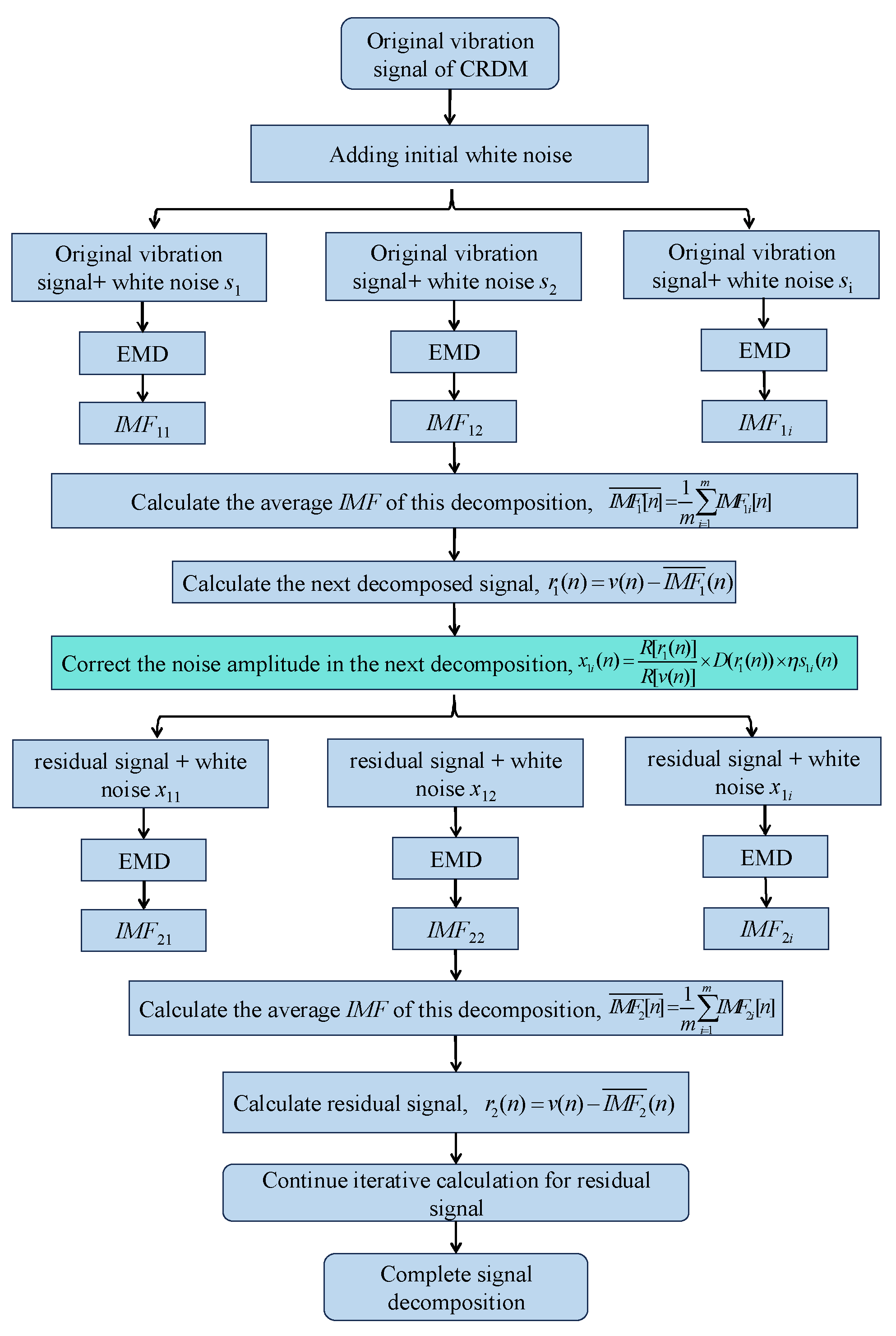
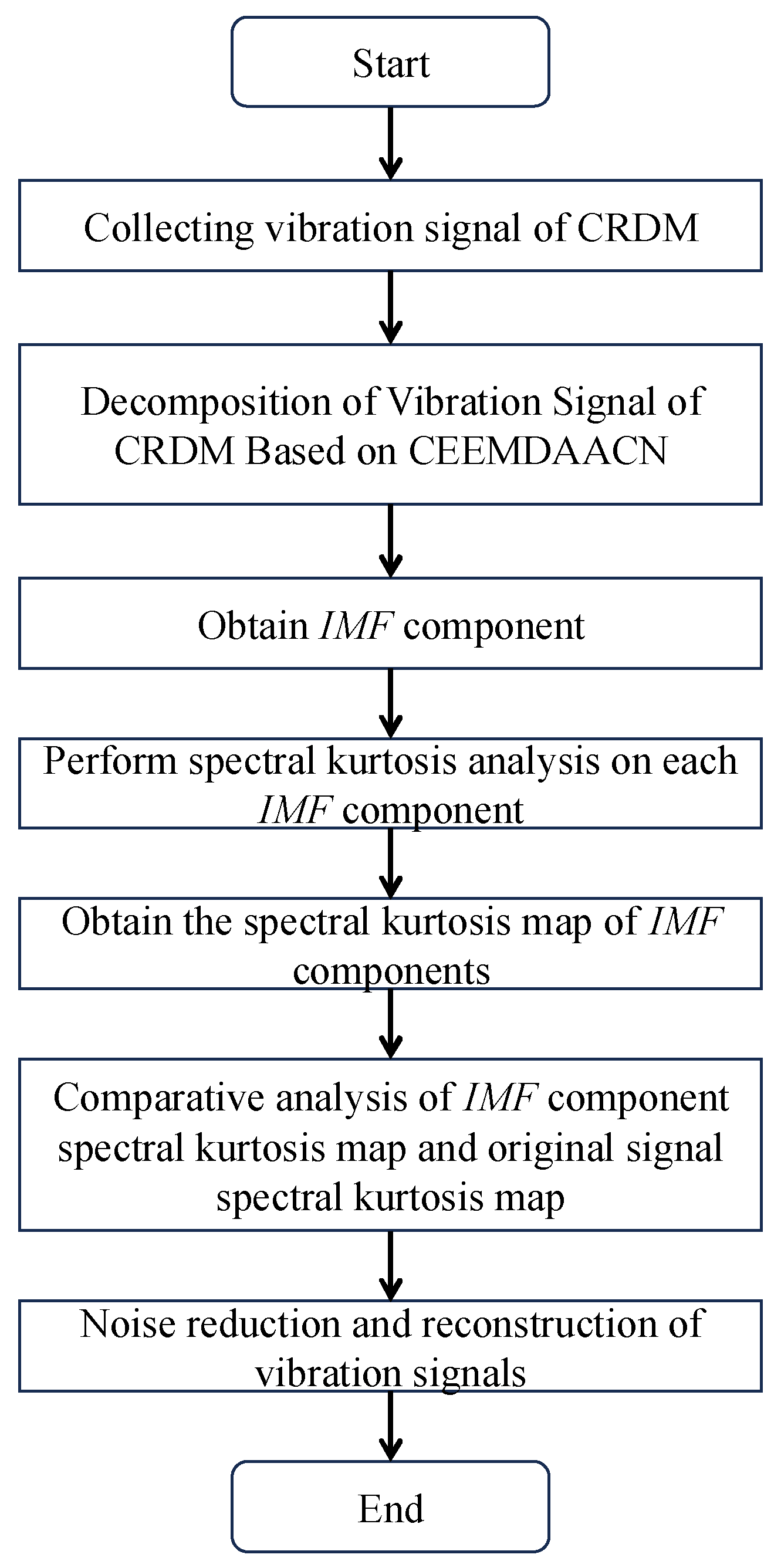
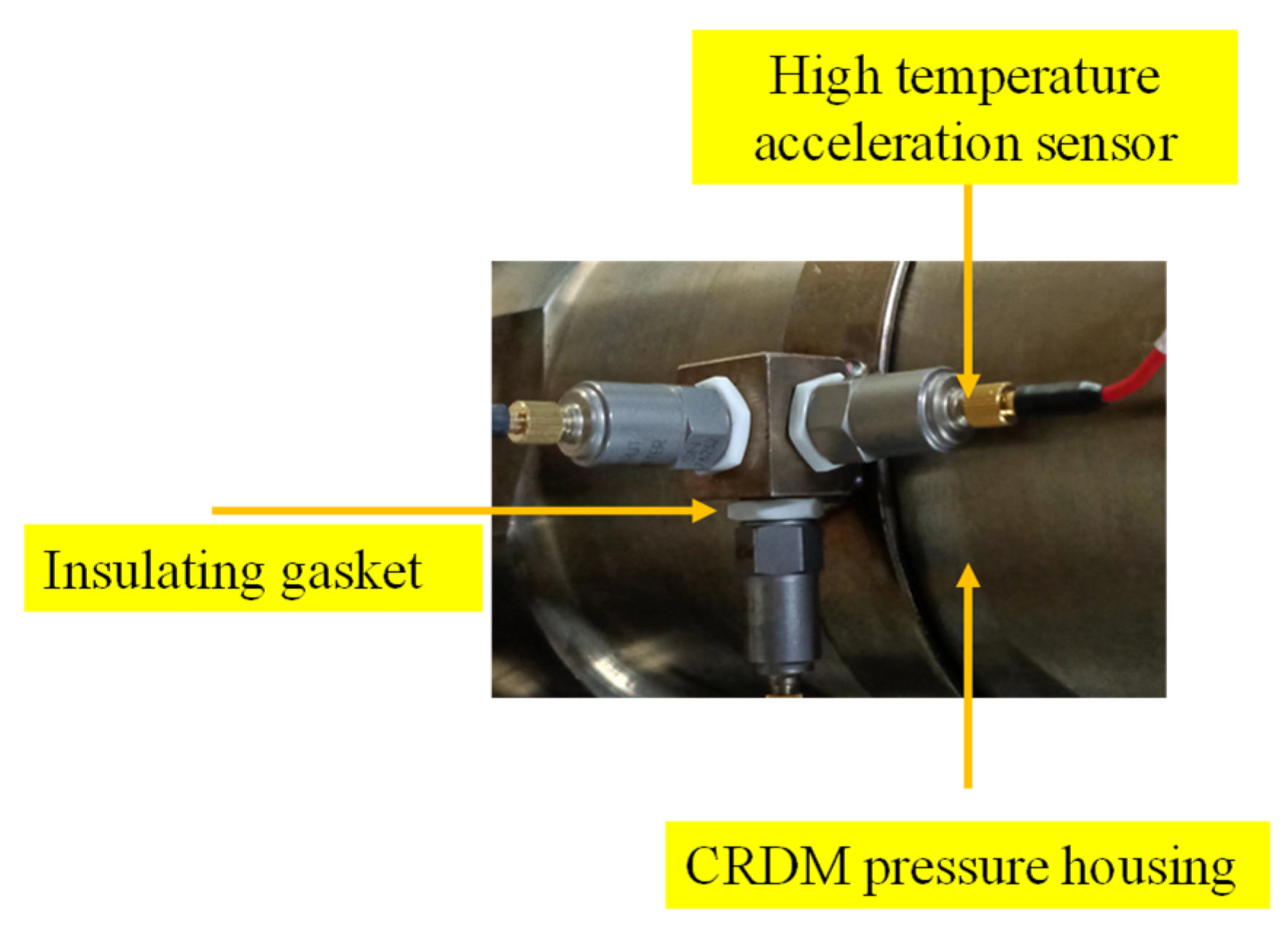




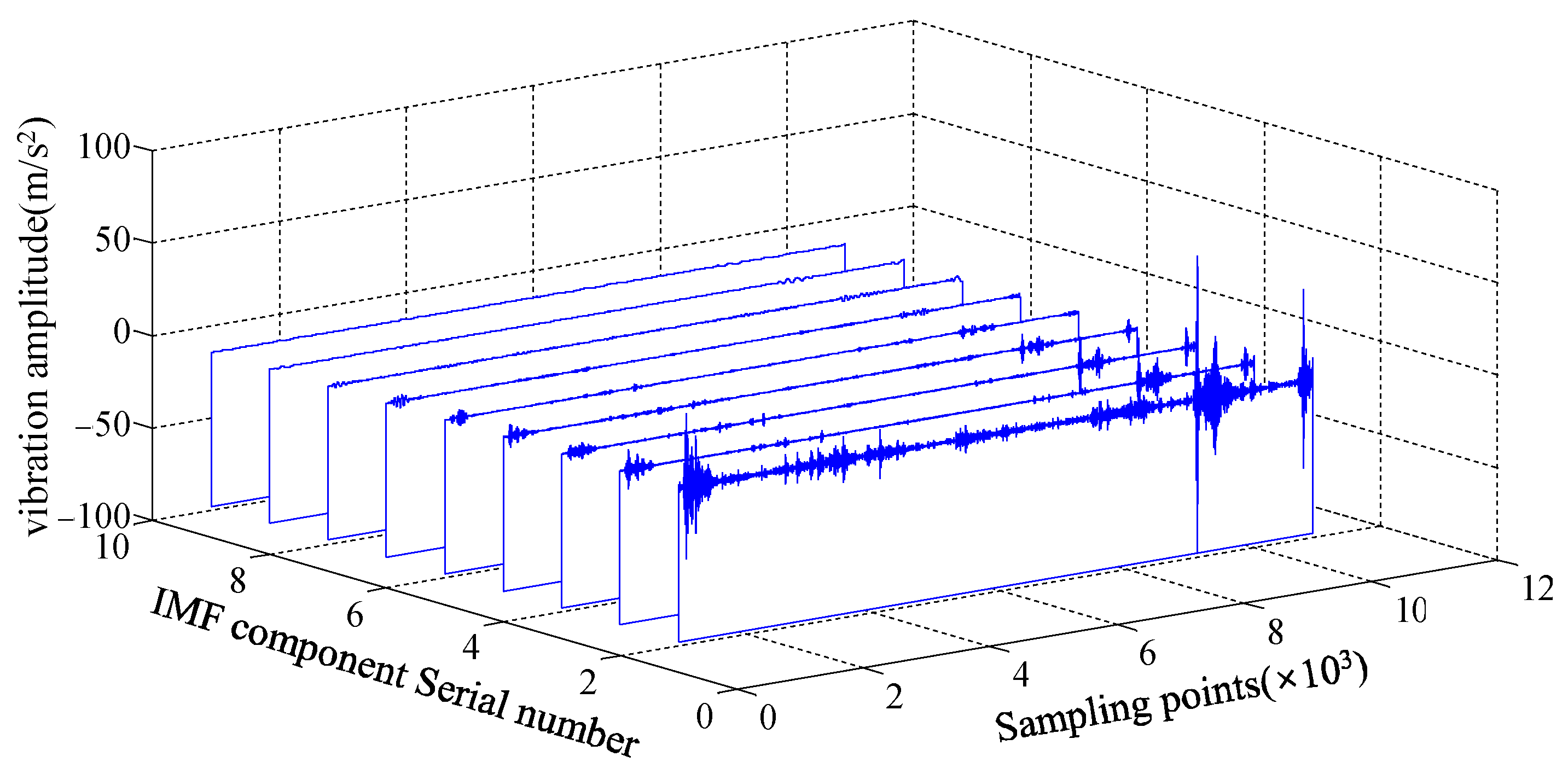

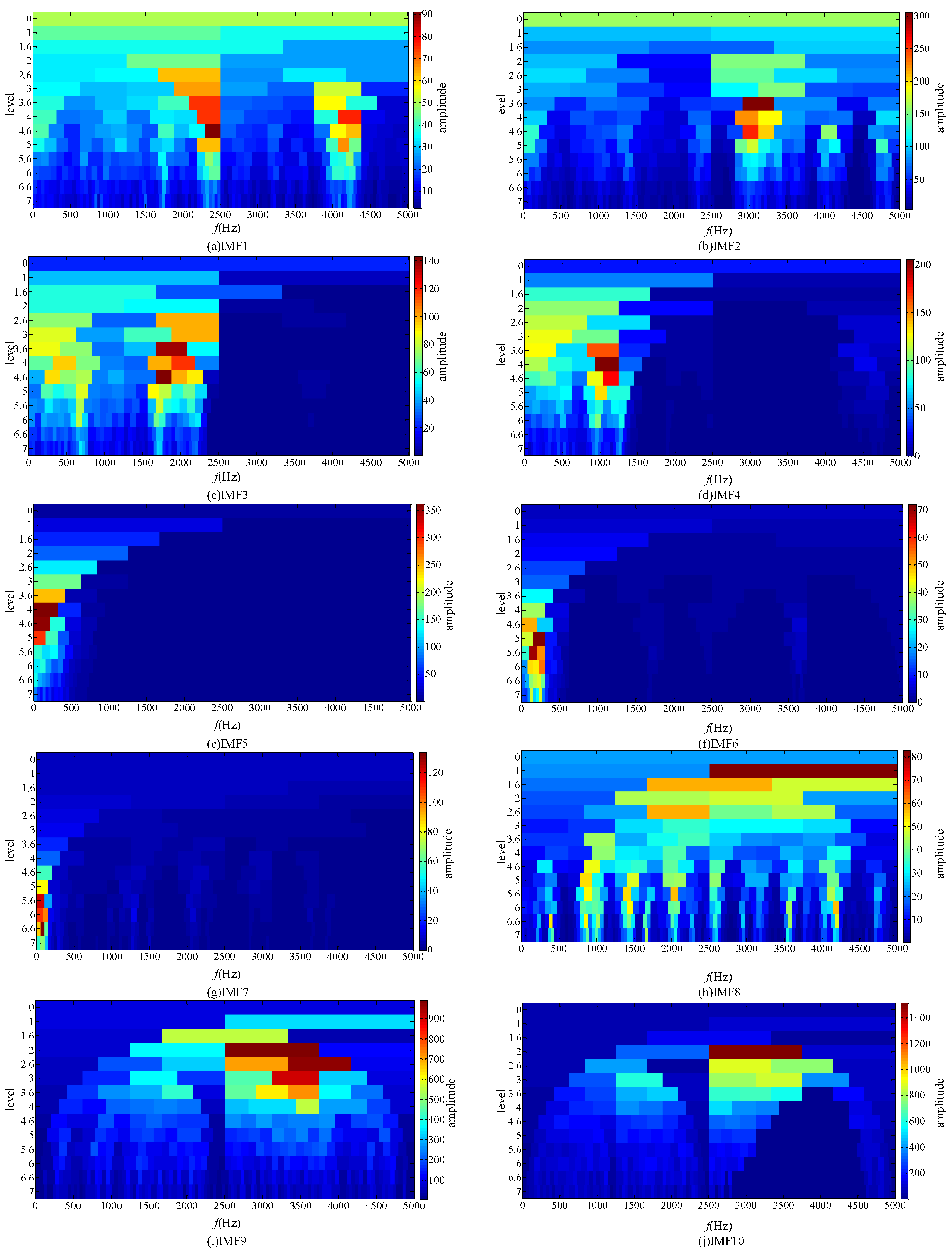
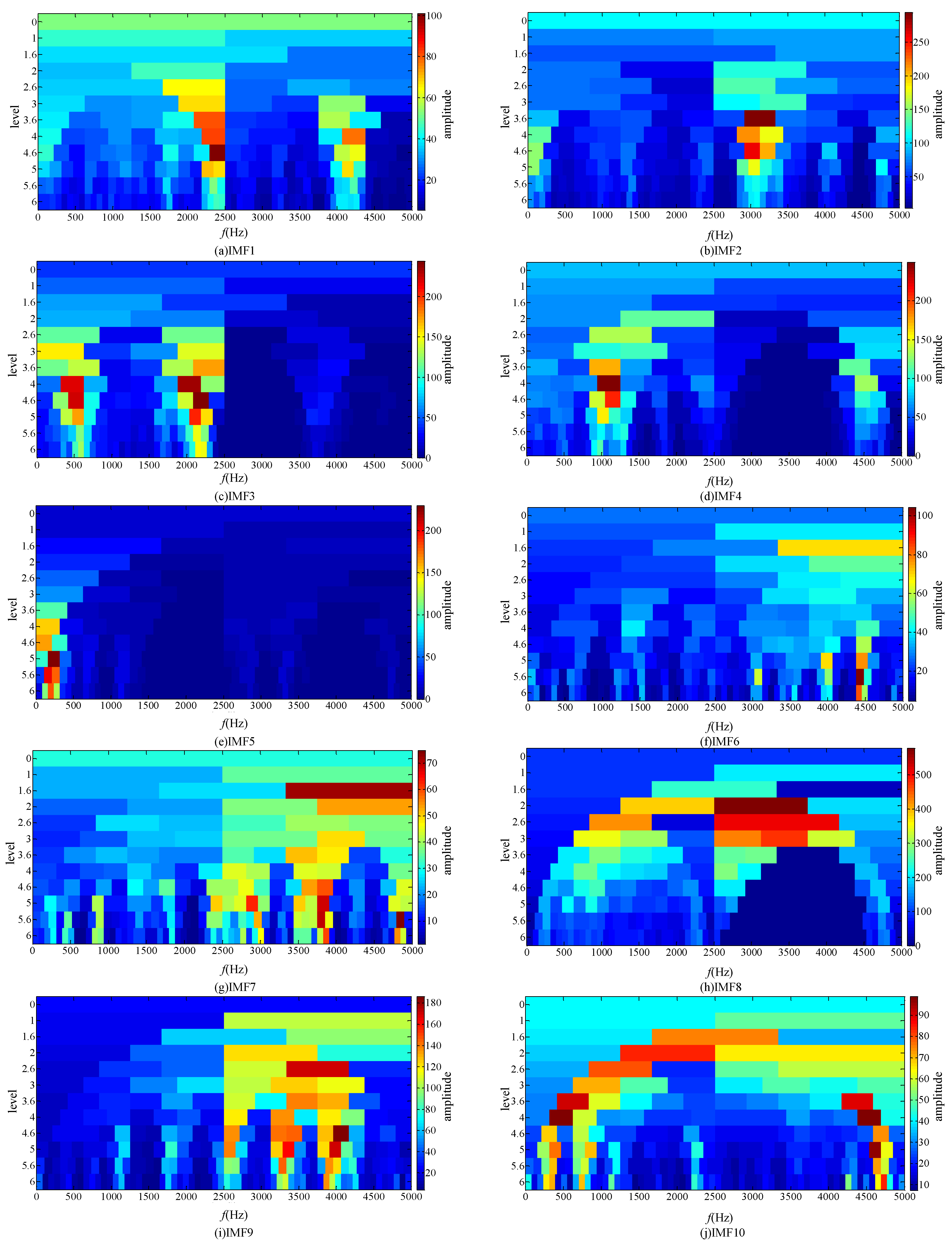

| Main References | Research Contents of References | Reference Contribution | Notes |
|---|---|---|---|
| Refs. [1,2,3,4,5,6] | Reliability optimization and design of CRDM | Design reliability of CRDM | Lack of CRDM vibration signal processing and noise reduction technology research |
| Refs. [7,8,9,10] | Reliability and function analysis of CRDM | Function analysis and reliability analysis of CRDM | |
| Refs. [11,12,13,14] | Fault analysis and detection | Robot fault detection, physical degradation analysis and dynamic modeling | |
| Refs. [15,16] | Analysis of rod drop performance | Test and analysis of the performance parameters of CRDM | |
| Refs. [17,18,19,20,21,22,23,24,25,26,27,28,29,30] | Signal noise reduction and application methods in various fields | Signal noise reduction technology | In the existing EEMD, CEEMDAN and other methods, the white noise amplitude added has poor correlation with the signal itself, and the selection criteria of white noise amplitude is not clear enough. |
| Decomposition Algorithm of Vibration Signal | Value of Algorithm Evaluation Index δ |
|---|---|
| CEEMDAN [31,32] | 0.384 |
| CEEMDAACN | 0.088 |
| Noise Reduction Method | IMF Component for Signal Reconstruction | Frequency Interval with Maximum Kurtosis Value |
|---|---|---|
| CEEMDAN-SK [35] | IMF8 | 2500–5000 Hz |
| CEEMDAACN-SK | IMF6, IMF7 | 3400–5000 Hz |
| LCEEMDAN | LCEEMDAACN | L |
|---|---|---|
| 2500 Hz | 1600 Hz | 36% |
Disclaimer/Publisher’s Note: The statements, opinions and data contained in all publications are solely those of the individual author(s) and contributor(s) and not of MDPI and/or the editor(s). MDPI and/or the editor(s) disclaim responsibility for any injury to people or property resulting from any ideas, methods, instructions or products referred to in the content. |
© 2023 by the authors. Licensee MDPI, Basel, Switzerland. This article is an open access article distributed under the terms and conditions of the Creative Commons Attribution (CC BY) license (https://creativecommons.org/licenses/by/4.0/).
Share and Cite
Liu, Z.; Li, T.; Zhu, Z.; Li, M.; Nie, C.; Tang, Z. Noise Reduction Method for the Vibration Signal of Reactor CRDM Based on CEEMDAACN-SK. Electronics 2023, 12, 4681. https://doi.org/10.3390/electronics12224681
Liu Z, Li T, Zhu Z, Li M, Nie C, Tang Z. Noise Reduction Method for the Vibration Signal of Reactor CRDM Based on CEEMDAACN-SK. Electronics. 2023; 12(22):4681. https://doi.org/10.3390/electronics12224681
Chicago/Turabian StyleLiu, Zhilong, Tongxi Li, Zhifeng Zhu, Minggang Li, Changhua Nie, and Zhangchun Tang. 2023. "Noise Reduction Method for the Vibration Signal of Reactor CRDM Based on CEEMDAACN-SK" Electronics 12, no. 22: 4681. https://doi.org/10.3390/electronics12224681






